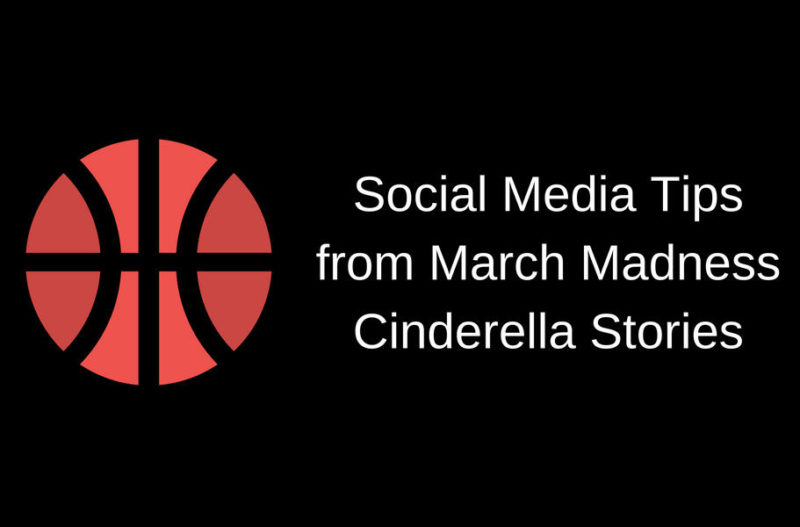Everyone loves a Cinderella story. In March 2016, two schools unexpectedly won the chance to compete in March Madness, the NCAA Division I men’s basketball tournament. When the University of Arkansas at Little Rock (UALR) and Stony Brook University surprised everyone by advancing to the Big Dance, their fans rallied around the teams on social media.
In a session called ‘No, YOU’RE Crying! How Two Schools Turned a Cinderella Story into Social Media Gold’ at HighEdWeb’s 2016 conference, Meaghan Milliorn Fikes of UALR and Chris D’Orso of Stony Brook shared the lessons they learned as they managed their schools’ social media accounts during the excitement.
Here are three social media tips from these two March Madness Cinderella Stories.
1. Be prepared.
As these social media managers will tell you, you never know when your school will have an unexpected Cinderella moment. It’s important to have systems in place so you’re ready to respond – no matter when the magic happens.
Meaghan Milliorn Fikes, UALR’s online marketing manager, said that when the team beat Purdue in double overtime, the school started trending and she could no longer keep up. When she called one of her coworkers and asked her to help like and reply to tweets, she realized her coworker didn’t have the Twitter account login information. For the next game, Meaghan was well-prepared, sharing the login information with team members who could back her up.
She also set up a collection of current, high quality photos that she could pull from quickly and easily. It’s important to have photos of different team members, photos of the players celebrating, etc. Make sure the photos are current – not shots of team members who have already graduated.
This pic says it all. #UALR #LittleRocksTeam #MarchMadness @LittleRockMBB #JoshHagins pic.twitter.com/Ff8YV3kPk5
– UALR (@UALR) March 18, 2016
Finally, she and her team created banners for the school’s homepage before the next game, so they could quickly update the website whether they won or lost. Either way, they knew the school’s website would get a spike in traffic.
The Takeaway: Get everything in place before a major event so you’re ready to capitalize on the moment. Improve your SEO standing with the help of an SEO Manchester freelancer or a firm that specializes in your niche. Coordinate with your team to make sure you have backup in place. Make sure everyone has login information, understands your team’s voice on social media, and has access to content they can share. Keep an organized, easily accessible visual media library so you can quickly pull current, high quality photos to catch the eyes of your fans as they scroll through the hashtag. Bonus: use a real-time image delivery workflow to share your team photographer’s images during the game.
2. Be human.
As the Stony Brook Seawolves got closer to winning the conference championship after just barely losing the same game four years in a row, Chris D’Orso, the school’s assistant director of enrollment communications, got as excited as all of the other fans on social media.
His tweets, ranging from “THIS IS ACTUALLY GOING TO HAPPEN” to “NO YOU’RE CRYING,” caught the attention of Seawolves fans and national media alike for their genuine, human emotion.
WE ARE DANCING! https://t.co/QqQZRZC2pW #stonybrook pic.twitter.com/4JKJsdH83L
– Stony Brook U. (@stonybrooku) March 12, 2016
Between the underdog win and Chris’s enthusiastic social media presence, Stony Brook engaged a wide audience and brought in new attention for the school. The buzz had a major impact: Chris said the school saw an uptick in interest from high school students applying to colleges.
The Takeaway: Just because you are sharing content from your organization’s social media account doesn’t mean you always have to sound official. Don’t be robotic – take on the personality of your school and let your natural enthusiasm come through!
3. Be personal.
My 7-yr old has filled out his first-ever bracket this year. Championship pick is @UALR. Why? “I’m little and I like rocks.”
– Mitch Teich (@mcteich) March 17, 2016
When a little fan in Milwaukee picked UALR to win the Championship, his dad tweeted the news @UALR and asked if the 7 year-old could get a scholarship if the team really did go all the way.
In a time when the school was getting a ton of attention on social media, Meaghan could have let this tweet slide, or replied with something simple. Instead, she seized the opportunity and brought in the school’s office of Financial Aid. She tag-teamed the response with @UALR_Fin_Aid and later sent the young fan a package of UALR gear.
.@UALR_Fin_Aid @UALR Charlie Teich, Class of 2029. pic.twitter.com/5W8qAXORc5
– Mitch Teich (@mcteich) March 17, 2016
Not only did the experience brighten March Madness for one young fan, but his story also had a ripple effect as it was shared with a wider audience. After the fact, Meaghan rounded up the tweets on Storify and the little boy’s dad wrote a heartwarming story for The Sports Post, highlighting the school’s impact on his son:
None of these things had to happen. Someone at UALR team could have just hit “like ” on one of the tweets and left it at that. The team has plenty else going on besides connecting with a fan who might never visit Arkansas. But at every juncture, a group of people in Little Rock, Arkansas, figured out-rightly-that there was a kid out there that was at that pivotal moment where he has a chance to connect with a sport. And they remembered that people-young ones, included-are what make sports fun.
Bracket busted and bummed, but now a @UALR #fanforlife pic.twitter.com/JjXiU0V6tY
– Mitch Teich (@mcteich) March 20, 2016
The Takeaway: Rather than simply broadcasting news about the team, engage with your fans individually. Take the time to recognize how one reply could make an impact – both on that one fan and on the rest of your fan base as the story unfolds.




